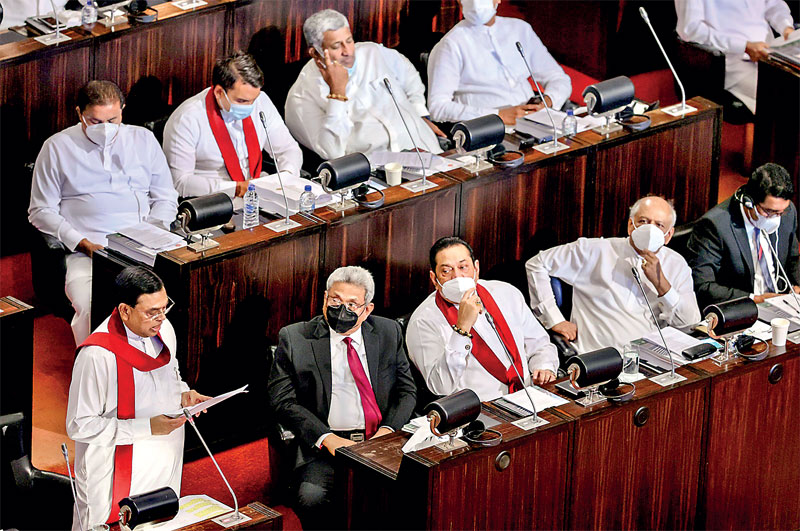Saturday Nov 29, 2025
Saturday Nov 29, 2025
Monday, 15 November 2021 00:00 - - {{hitsCtrl.values.hits}}

The two brothers attentively listen to their younger brother Basil Rajapaksa
 Budget proposals presented by the Minister of Finance Basil Rajapaksa, according to several analysts, make a huge effort to avoid penalising the population at the lower end of the income bracket and focuses on several proposals aimed at moving from an import dominant economy towards a manufacturing economy with greater emphasis on the export of goods and services and import substitution in identified sectors.
Budget proposals presented by the Minister of Finance Basil Rajapaksa, according to several analysts, make a huge effort to avoid penalising the population at the lower end of the income bracket and focuses on several proposals aimed at moving from an import dominant economy towards a manufacturing economy with greater emphasis on the export of goods and services and import substitution in identified sectors.
This is certainly what Sri Lanka needs. This strategy is certainly intended to reduce the overreliance on commercial foreign debt and to stem the foreign currency outflows. The Budget proposals also attempt to address the Government’s poor expenditure management and have recommended several proposals to manage the ever-increasing expenditure of the Government. Opposition lawmaker economist Dr. Harsha de Silva said the Budget was totally disappointing. He further said there was nothing in it to address the major structural issues of fiscal and balance of payments deficits; also lacked new plans on investments, exports, technology and innovation, and plans to address the unbearable cost of living (COL). A former State Minister of Finance, ex-banker Eran Wickremaratne said the Budget had failed to introduce a solution to the mounting Dollar crisis, which would badly hit Sri Lanka in the first quarter of 2022. The Government should address both their concerns in the ensuing budget debate while leaving the politics aside.
Real impact
Budget 2022 has not addressed the COL effectively and the needs of the country’s struggling tourism sector, which is desperately in need of Government support to help them ride out the crisis. Moreover, instead of extending the moratoriums, the Government should have intelligently come out with a solution to address the moratoriums, given that the sector is set to recover in early 2023.
The tourism sector is key to a sustainable resolution according to several analysts to the accumulating Dollar crisis. The Government, to its credit, has certainly helped the industry by extending the moratoriums despite the negative impact on banking sector cash flows and their overseas borrowing ability. However, the focus on developing an export-oriented economy and the identification of sectors to incentivise is a step in the right direction. This should have happened several years ago. Backward and forward integration of certain industries is vital for the development of efficient supply chains. The selective handholding, a well-articulated FDI strategy to attract investors and planned expansion of manufacturing will be critical for an import substitution strategy. The move to consolidate charges, which are currently being charged by the Board of Investment (BOI), Export Development Board (EDB) as well as the Special Goods and Services Tax (Special GST) is also a good move. Given the drive to increase female participation in the workforce, the intervention to encourage women-centric enterprises and incentives extended for start-ups with registration-free initiatives is good, but a lot more needs to happen to make a real impact. Doing away with the business registration fee for startups by youth is a good step. The creation of Agro parks and three additional techno parks and mini supermarket networks at the local level are positive moves.
However, not much emphasis was placed on software exports and supporting the SME sector. Skills development should have been better emphasised given the drive towards a manufacturing economy. The Government should be using our overseas missions more effectively to look for foreign market opportunities for small and medium scale entrepreneurs to identify exports. The Surcharge Tax at 25% on persons and companies with taxable income exceeding Rs. 2 billion and the Social Security Contribution on liable turnover exceeding Rs. 120 million at the rate of 2.5% is clearly a proposal to bump up government revenue. The continuing import restrictions on non-critical imports is a good move and clearly aimed at protecting the forex reserves.
Conclusion
Whilst the proposals do not propose any substantial changes to the existing tax structures, they certainly focus on improving the critical infrastructure of the country and providing some relief to the communities hit severely by the pandemic and now hit by the increasing COL. The targeted Rs. 1.6 trillion fiscal deficit for 2022 is an improvement from the Rs. 1.8 trillion deficit for 2021, therefore with the primary deficit at 2.8%, the Government is looking to continue its dependency on financing the deficit through domestic sources.
This would continue to push interest rates further up and the Government would be forced to cut down on its aggressive public investment spending in 2022. Overall, the Budget proposals would need to be supercharged to enhance the bandwidth to address the current economic crisis we are facing on multiple fronts. Also, like every Budget in the last decade, the challenge will be in the implementation of the proposals, given our weak bench strength and the politicisation in the public sector.